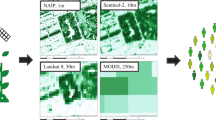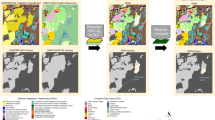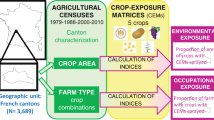Abstract
Background
Epidemiologic investigations increasingly employ remote sensing data to estimate residential proximity to agriculture as a means of approximating individual-level pesticide exposure. Few studies have examined the accuracy of these methods and the implications for exposure misclassification.
Objectives
Compare metrics of residential proximity to agricultural land between a groundtruth approach and commonly-used satellite-based estimates.
Methods
We inspected 349 fields and identified crops in current production within a 0.5 km radius of 40 residences in Idaho. We calculated the distance from each home to the nearest agricultural field and the total acreage of agricultural fields within a 0.5 km buffer. We compared these groundtruth estimates to satellite-derived estimates from three widely used datasets: CropScape, the National Land Cover Database (NLCD), and Landsat imagery (using Normalized Difference Vegetation Index thresholds).
Results
We found poor to moderate agreement between the classification of individuals living within 0.5 km of an agricultural field between the groundtruth method and the comparison datasets (53.1–77.6%). All satellite-derived estimates overestimated the acreage of agricultural land within 0.5 km of each home (average = 82.8–148.9%). Using two satellite-derived datasets in conjunction resulted in substantial improvements; specifically, combining CropScape or NLCD with Landsat imagery had the highest percent agreement with the groundtruth data (92.8–93.8% agreement).
Significance
Residential proximity to agriculture is frequently used as a proxy for pesticide exposure in epidemiologic investigations, and remote sensing-derived datasets are often the only practical means of identifying cultivated land. We found that estimates of agricultural proximity obtained from commonly-used satellite-based datasets are likely to result in exposure misclassification. We propose a novel approach that capitalizes on the complementary strengths of different sources of satellite imagery, and suggest the combined use of one dataset with high temporal resolution (e.g., Landsat imagery) in conjunction with a second dataset that delineates agricultural land use (e.g., CropScape or NLCD).
This is a preview of subscription content, access via your institution
Access options
Subscribe to this journal
Receive 6 print issues and online access
$259.00 per year
only $43.17 per issue
Buy this article
- Purchase on Springer Link
- Instant access to full article PDF
Prices may be subject to local taxes which are calculated during checkout







Similar content being viewed by others
Data availability
To protect the privacy of our participants, data from this analysis are not available.
References
Hyland C, Laribi O. Review of take-home pesticide exposure pathway in children living in agricultural areas. Environ Res. 2017;156:559–70.
Lopez-Galvez N, Wagoner R, Quiros-Alcala L, Ornelas Van Horne Y, Furlong M, Avila E, et al. Systematic Literature Review of the Take-Home Route of Pesticide Exposure via Biomonitoring and Environmental Monitoring. Int J Environ Res Public Health. 2019;16:2177.
Deziel NC, Freeman LEB, Graubard BI, Jones RR, Hoppin JA, Thomas K, et al. Relative Contributions of Agricultural Drift, Para-Occupational, and Residential Use Exposure Pathways to House Dust Pesticide Concentrations: Meta-Regression of Published Data. Environ Health Perspect. 2017;125:296–305.
Deziel NC, Friesen MC, Hoppin JA, Hines CJ, Thomas K, Freeman LE. A review of nonoccupational pathways for pesticide exposure in women living in agricultural areas. Environ Health Perspect. 2015;123:515–24.
Larsen AE, Gaines SD, Deschênes O. Agricultural pesticide use and adverse birth outcomes in the San Joaquin Valley of California. Nat Commun. 2017;8:302.
Gemmill A, Gunier Robert B, Bradman A, Eskenazi B, Harley Kim G. Residential Proximity to Methyl Bromide Use and Birth Outcomes in an Agricultural Population in California. Environ Health Perspect. 2013;121:737–43.
Rappazzo KM, Warren JL, Meyer RE, Herring AH, Sanders AP, Brownstein NC, et al. Maternal residential exposure to agricultural pesticides and birth defects in a 2003 to 2005 North Carolina birth cohort. Birth Defects Res Part A: Clin Mol Teratol. 2016;106:240–9.
Rull RP, Ritz B, Shaw GM. Neural Tube Defects and Maternal Residential Proximity to Agricultural Pesticide Applications. Am J Epidemiol. 2006;163:743–53.
Carmichael SL, Yang W, Ma C, Roberts E, Kegley S, English P, et al. Joint effects of genetic variants and residential proximity to pesticide applications on hypospadias risk. Birth Defects Res Part A: Clin Mol Teratol. 2016;106:653–8.
Meyer Kristy J, Reif John S, Veeramachaneni DNR, Luben Thomas J, Mosley Bridget S, Nuckols John R. Agricultural Pesticide Use and Hypospadias in Eastern Arkansas. Environ Health Perspect. 2006;114:1589–95.
Carozza SE, Li B, Wang Q, Horel S, Cooper S. Agricultural pesticides and risk of childhood cancers. Int J Hyg Environ Health. 2009;212:186–95.
Gómez-Barroso D, García-Pérez J, López-Abente G, Tamayo-Uria I, Morales-Piga A, Pardo Romaguera E, et al. Agricultural crop exposure and risk of childhood cancer: new findings from a case–control study in Spain. Int J Health Geogr. 2016;15:18.
Rull RP, Gunier R, Von Behren J, Hertz A, Crouse V, Buffler PA, et al. Residential proximity to agricultural pesticide applications and childhood acute lymphoblastic leukemia. Environ Res. 2009;109:891–9.
Hyland C, Gunier RB, Metayer C, Bates MN, Wesseling C, Mora AM. Maternal residential pesticide use and risk of childhood leukemia in Costa Rica. Int J Cancer. 2018;143:1295–304.
Lombardi C, Thompson S, Ritz B, Cockburn M, Heck JE. Residential proximity to pesticide application as a risk factor for childhood central nervous system tumors. Environ Res. 2021;197:111078.
Park AS, Ritz B, Yu F, Cockburn M, Heck JE. Prenatal pesticide exposure and childhood leukemia - A California statewide case-control study. Int J Hyg Environ Health. 2020;226:113486.
Jones RR, Yu C-L, Nuckols JR, Cerhan JR, Airola M, Ross JA, et al. Farm residence and lymphohematopoietic cancers in the Iowa Women׳s Health Study. Environ Res. 2014;133:353–61.
Carles C, Bouvier G, Esquirol Y, Piel C, Migault L, Pouchieu C, et al. Residential proximity to agricultural land and risk of brain tumor in the general population. Environ Res. 2017;159:321–30.
El-Zaemey S, Heyworth J, Fritschi L. Noticing pesticide spray drift from agricultural pesticide application areas and breast cancer: a case-control study. Aust NZ J Public Health. 2013;37:547–55.
Raanan R, Gunier Robert B, Balmes John R, Beltran Alyssa J, Harley Kim G, Bradman A, et al. Elemental Sulfur Use and Associations with Pediatric Lung Function and Respiratory Symptoms in an Agricultural Community (California, USA). Environ Health Perspect. 2017;125:087007.
Coker E, Gunier R, Bradman A, Harley K, Kogut K, Molitor J, et al. Association between Pesticide Profiles Used on Agricultural Fields near Maternal Residences during Pregnancy and IQ at Age 7 Years. Int J Environ Res Public Health. 2017;14:506.
Gunier RB, Bradman A, Harley KG, Kogut K, Eskenazi B. Prenatal Residential Proximity to Agricultural Pesticide Use and IQ in 7-Year-Old Children. Environ Health Perspect. 2017;125:057002.
Hyland C, Bradshaw PT, Gunier RB, Mora AM, Kogut K, Deardorff J, et al. Associations between pesticide mixtures applied near home during pregnancy and early childhood with adolescent behavioral and emotional problems in the CHAMACOS study. Environ Epidemiol. 2021;5:e150.
Sagiv SK, Harris MH, Gunier RB, Kogut KR, Harley KG, Deardorff J, et al. Prenatal Organophosphate Pesticide Exposure and Traits Related to Autism Spectrum Disorders in a Population Living in Proximity to Agriculture. Environ Health Perspect. 2018;126:047012.
Shelton JF, Geraghty EM, Tancredi DJ, Delwiche LD, Schmidt RJ, Ritz B, et al. Neurodevelopmental Disorders and Prenatal Residential Proximity to Agricultural Pesticides: The CHARGE Study. Environ Health Perspect. 2014;122:1103–9.
Brouwer M, Huss A, van der Mark M, Nijssen PCG, Mulleners WM, Sas AMG, et al. Environmental exposure to pesticides and the risk of Parkinson’s disease in the Netherlands. Environ Int. 2017;107:100–10.
Costello S, Cockburn M, Bronstein J, Zhang X, Ritz B. Parkinson’s Disease and Residential Exposure to Maneb and Paraquat From Agricultural Applications in the Central Valley of California. Am J Epidemiol. 2009;169:919–26.
Wang A, Costello S, Cockburn M, Zhang X, Bronstein J, Ritz B. Parkinson’s disease risk from ambient exposure to pesticides. Eur J Epidemiol. 2011;26:547–55.
Wang A, Cockburn M, Ly TT, Bronstein JM, Ritz B. The association between ambient exposure to organophosphates and Parkinson's disease risk. Occup Environ Med. 2014;71:275.
Manthripragada AD, Costello S, Cockburn MG, Bronstein JM, Ritz B. Paraoxonase 1, agricultural organophosphate exposure, and Parkinson disease. Epidemiol (Camb, Mass). 2010;21:87–94.
Dereumeaux C, Fillol C, Quenel P, Denys S. Pesticide exposures for residents living close to agricultural lands: a review. Environ Int. 2020;134:105210.
Teysseire R, Manangama G, Baldi I, Carles C, Brochard P, Bedos C, et al. Assessment of residential exposures to agricultural pesticides: a scoping review. PloS ONE. 2020;15:e0232258–e.
Barr DB. Biomonitoring of exposure to pesticides. J Chem Health Saf. 2008;15:20–9.
O’Leary ES, Vena JE, Freudenheim JL, Brasure J. Pesticide exposure and risk of breast cancer: a nested case-control study of residentially stable women living on Long Island. Environ Res. 2004;94:134–44.
Brody JG, Vorhees DJ, Melly SJ, Swedis SR, Drivas PJ, Rudel RA. Using GIS and historical records to reconstruct residential exposure to large-scale pesticide application. J Expo Anal Environ Epidemiol. 2002;12:64–80.
Rull RP, Ritz B, Shaw GM. Validation of self-reported proximity to agricultural crops in a case–control study of neural tube defects. J Expo Sci Environ Epidemiol. 2006;16:147–55.
Plascak JJ, Griffith WC, Workman T, Smith MN, Vigoren E, Faustman EM, et al. Evaluation of the relationship between residential orchard density and dimethyl organophosphate pesticide residues in house dust. J Expo Sci Environ Epidemiol. 2019;29:379–88.
Warren JL, Luben TJ, Sanders AP, Brownstein NC, Herring AH, Meyer RE. An evaluation of metrics for assessing maternal exposure to agricultural pesticides. J Expo Sci Environ Epidemiol. 2014;24:497–503.
Avruskin GA, Meliker JR, Jacquez GM. Using satellite derived land cover information for a multi-temporal study of self-reported recall of proximity to farmland. J Expo Sci Environ Epidemiol. 2008;18:381–91.
Ward MH, Nuckols JR, Weigel SJ, Maxwell SK, Cantor KP, Miller RS. Identifying populations potentially exposed to agricultural pesticides using remote sensing and a Geographic Information System. Environ Health Perspect. 2000;108:5–12.
Ward MH, Lubin J, Giglierano J, Colt JS, Wolter C, Bekiroglu N, et al. Proximity to crops and residential exposure to agricultural herbicides in iowa. Environ Health Perspect. 2006;114:893–7.
Maxwell SK, Airola M, Nuckols JR. Using Landsat satellite data to support pesticide exposure assessment in California. Int J Health Geogr. 2010;9:46.
Maxwell SK. Downscaling Pesticide Use Data to the Crop Field Level in California Using Landsat Satellite Imagery: Paraquat Case Study. Remote Sensing. 2011;3:1805–16.
VoPham T, Wilson JP, Ruddell D, Rashed T, Brooks MM, Yuan JM, et al. Linking pesticides and human health: a geographic information system (GIS) and Landsat remote sensing method to estimate agricultural pesticide exposure. Appl Geogr. 2015;62:171–81.
Gibson EA, Goldsmith J, Kioumourtzoglou M-A. Complex Mixtures, Complex Analyses: an Emphasis on Interpretable Results. Curr Environ health Rep. 2019;6:53–61.
Hamra GB, Buckley JP. Environmental exposure mixtures: questions and methods to address them. Curr. 2018;5:160–5.
Brody JG, Aschengrau A, McKelvey W, Rudel RA, Swartz CH, Kennedy T. Breast cancer risk and historical exposure to pesticides from wide-area applications assessed with GIS. Environ Health Perspect. 2004;112:889–97.
VoPham T, Brooks MM, Yuan JM, Talbott EO, Ruddell D, Hart JE, et al. Pesticide exposure and hepatocellular carcinoma risk: A case-control study using a geographic information system (GIS) to link SEER-Medicare and California pesticide data. Environ Res. 2015;143:68–82.
Marusek JC, Cockburn MG, Mills PK, Ritz BR. Control selection and pesticide exposure assessment via GIS in prostate cancer studies. Am J Prev Med. 2006;30:S109–16.
Bukalasa JS, Brunekreef B, Brouwer M, Koppelman GH, Wijga AH, Huss A, et al. Associations of residential exposure to agricultural pesticides with asthma prevalence in adolescence: the PIAMA birth cohort. Environ Int. 2018;121:435–42.
Meyer KJ, Reif JS, Veeramachaneni DNR, Luben TJ, Mosley BS, Nuckols JR. Agricultural pesticide use and hypospadias in eastern Arkansas. Environ Health Perspect. 2006;114:1589–95.
Ochoa-Acuña H, Carbajo C. Risk of limb birth defects and mother’s home proximity to cornfields. Sci Total Environ. 2009;407:4447–51.
Xiang H, Nuckols JR, Stallones L. A geographic information assessment of birth weight and crop production patterns around mother’s residence. Environ Res. 2000;82:160–7.
Friedman E, Hazlehurst M, Loftus C, Karr C, McDonald K, Suarez-Lopez J. Residential proximity to greenhouse agriculture and neurobehavioral performance in Ecuadorian children. Int J Hyg Environ Health. 2019;223:220–7.
Suarez-Lopez J, Hong V, McDonald K, Suarez-Torres J, López D, Cruz F. Home proximity to flower plantations and higher systolic blood pressure among children. Int J Hyg Environ Health. 2018;221:1077–84.
Rull RP, Ritz B. Historical pesticide exposure in California using pesticide use reports and land-use surveys: an assessment of misclassification error and bias. Environ Health Perspect. 2003;111:1582–9.
Ochoa-Acuña H, Carbajo C. Risk of limb birth defects and mother’s home proximity to cornfields. Sci Total Environ. 2009;407:4447–51.
Xiang H, Nuckols JR, Stallones L. A Geographic Information Assessment of Birth Weight and Crop Production Patterns around Mother’s Residence. Environ Res. 2000;82:160–7.
Jones RR, Yu CL, Nuckols JR, Cerhan JR, Airola M, Ross JA, et al. Farm residence and lymphohematopoietic cancers in the Iowa Women’s Health Study. Environ Res. 2014;133:353–61.
United States Department of Agriculture (USDA) National Agricultural Statistics Service. Reserach and Science. CropScape and Cropland Data Layers - FAQs 2021 https://www.nass.usda.gov/Research_and_Science/Cropland/sarsfaqs2.php.
Multi-Resolution Land Characteristics Consortium (MRLC). Land Cover 2019 https://www.mrlc.gov/data/type/land-cover#:~:text=The%20National%20Land%20Cover%20Database,land%20cover%20and%20associated%20changes.
United States Geological Survey (USGS). What are the band designations for the Landsat satellites? 2021 https://www.usgs.gov/faqs/what-are-band-designations-landsat-satellites.
Esri. World Imagery Basemap https://www.arcgis.com/home/item.html?id=10df2279f9684e4a9f6a7f08febac2a9.
Pebesma E. Simple Features for R: Standardized Support for Spatial Vector Data. R J. 2018;10:439–46.
Hijmans RJ, van Etten J raster: Geographic analysis and modeling with raster data. R package version 2.0-12. 2012 http://CRAN.R-project.org/package=raster.
Dorman M, Rush J, Hough I, Russel D, Ranghetti L, Benini A, et al. nngeo: k-Nearest Neighbor Join for Spatial Data https://cran.r-project.org/web/packages/nngeo/index.html.
Wickham A, Averick M, Bryan J, Chang W, McGowan L, François R, et al. Welcome to the tidyverse. J Open Source Softw. 2019;4:1686.
Boryan C, Yang Z, Mueller R, Craig M. Monitoring US agriculture: the US Department of Agriculture, National Agricultural Statistics Service, Cropland Data Layer Program. Geocarto Int. 2011;26:341–58.
Chen B. Package ‘CropScapeR’ package version 1.1.1. 2021 [Available from: https://cran.r-project.org/web/packages/CropScapeR/CropScapeR.pdf].
United States Department of Agriculture (USDA) National Agricultural Statistics Service (NASS). 2020 Idaho Cropland Data Lyaer | NASS/USDA 2020 https://www.nass.usda.gov/Research_and_Science/Cropland/metadata/metadata_id20.htm.
Yang L, Jin S, Danielson P, Homer C, Gass L, Bender SM, et al. A new generation of the United States National Land Cover Database: Requirements, research priorities, design, and implementation strategies. ISPRS J Photogramm Remote Sens. 2018;146:108–23.
Pause M, Raasch F, Marrs C, Csaplovics E. Monitoring Glyphosate-Based Herbicide Treatment Using Sentinel-2 Time Series—A Proof-of-Principle. Remote Sens. 2019;11:2541.
Pettorelli N, Vik JO, Mysterud A, Gaillard JM, Tucker CJ, Stenseth NC. Using the satellite-derived NDVI to assess ecological responses to environmental change. Trends Ecol Evol. 2005;20:503–10.
United States Geological Survey (USGS). NDVI, the Foundation for Remote Sensing Phenology 2018 https://www.usgs.gov/special-topics/remote-sensing-phenology/science/ndvi-foundation-remote-sensing-phenology#:~:text=NDVI%20values%20range%20from%20%2B1.0,(approximately%200.2%20to%200.5).
Koo TK, Li MY. A Guideline of Selecting and Reporting Intraclass Correlation Coefficients for Reliability Research. J Chiropr Med. 2016;15:155–63.
Gibbs JL, Yost MG, Negrete M, Fenske RA. Passive Sampling for Indoor and Outdoor Exposures to Chlorpyrifos, Azinphos-Methyl, and Oxygen Analogs in a Rural Agricultural Community. Environ Health Perspect. 2017;125:333–41.
Jin S, Homer C, Yang L, Danielson P, Dewitz J, Li C, et al. Overall Methodology Design for the United States National Land Cover Database 2016 Products. Remote Sensing. 2019;11,2971.
Homer C, Dewitz J, Jin S, Xian G, Costello C, Danielson P, et al. Conterminous United States land cover change patterns 2001–2016 from the 2016 National Land Cover Database. ISPRS J Photogramm Remote Sens. 2020;162:184–99.
United States Geological Survey. What are the acquisition schedules for the Landsat satellites? https://www.usgs.gov/faqs/what-are-acquisition-schedules-landsat-satellites.
Dolven RI. Urban Sprawl and Farmland Protection: Responding to Changes in Idaho’s Treasure Valley. Idaho L Rev. 2021;269:269–96.
Maxwell A, Warner T, Vanderbilt B, Ramezan C. Land Cover Classification and Feature Extraction from National Agriculture Imagery Program (NAIP) Orthoimagery: a review. Photogrammetric Eng Remote Sens. 2017;83:737–47.
Cheng Y, Vrieling A, Fava F, Meroni M, Marshall M, Gachoki S. Phenology of short vegetation cycles in a Kenyan rangeland from PlanetScope and Sentinel-2. Remote Sens Environ. 2020;248:112004.
Breunig FM, Galvão LS, Dalagnol R, Dauve CE, Parraga A, Santi AL, et al. Delineation of management zones in agricultural fields using cover–crop biomass estimates from PlanetScope data. Int J Appl Earth Observation Geoinf. 2020;85:102004.
Turker M, Ozdarici A. Field-based crop classification using SPOT4, SPOT5, IKONOS and QuickBird imagery for agricultural areas: a comparison study. Int J Remote Sens. 2011;32:9735–68.
Kussul N, Lavreniuk M, Skakun S, Shelestov A. Deep Learning Classification of Land Cover and Crop Types Using Remote Sensing Data. IEEE Geosci Remote Sens Lett. 2017;14:778–82.
Neetu RaySS. Exploring Machine Learning Classification Algorithms for Crop Classification Using Sentinel 2 Data. Int Arch Photogramm Remote Sens Spat Inf Sci. 2019;XLII-3/W6:573–8.
Zurqani HA, Post CJ, Mikhailova EA, Cope MP, Allen JS, Lytle BA. Evaluating the integrity of forested riparian buffers over a large area using LiDAR data and Google Earth Engine. Sci Rep. 2020;10:14096.
Duda T, Canty M. Unsupervised classification of satellite imagery: choosing a good algorithm. Int J Remote Sens. 2002;23:2193–212.
United States Department of Agriculture (USDA) Economic Research Service. Major Land Uses https://www.ers.usda.gov/topics/farm-economy/land-use-land-value-tenure/major-land-uses/.
Acknowledgements
We gratefully acknowledge all of the study participants.
Funding
Research reported in this publication was supported by the National Institute of Environmental Health Sciences of the National Institutes of Health under Award Number K01ES028745. The content of this paper, including all findings and conclusions, is solely the responsibility of the authors and does not necessarily represent the official views of the National Institutes of Health.
Author information
Authors and Affiliations
Contributions
CH: Data Collection, Formal Analysis, Writing—Original Draft; KM, Conception of Data Analysis, Formal Analysis, Writing—Reviewing and Editing; ED, Formal Analysis, Writing—Reviewing and Editing; CLC: Conceptualization, Writing—Reviewing and Editing.
Corresponding author
Ethics declarations
Competing interests
The authors declare no competing interests.
Additional information
Publisher’s note Springer Nature remains neutral with regard to jurisdictional claims in published maps and institutional affiliations.
Supplementary information
Rights and permissions
Springer Nature or its licensor holds exclusive rights to this article under a publishing agreement with the author(s) or other rightsholder(s); author self-archiving of the accepted manuscript version of this article is solely governed by the terms of such publishing agreement and applicable law.
About this article
Cite this article
Hyland, C., McConnell, K., DeYoung, E. et al. Evaluating the accuracy of satellite-based methods to estimate residential proximity to agricultural crops. J Expo Sci Environ Epidemiol (2022). https://doi.org/10.1038/s41370-022-00467-0
Received:
Revised:
Accepted:
Published:
DOI: https://doi.org/10.1038/s41370-022-00467-0



